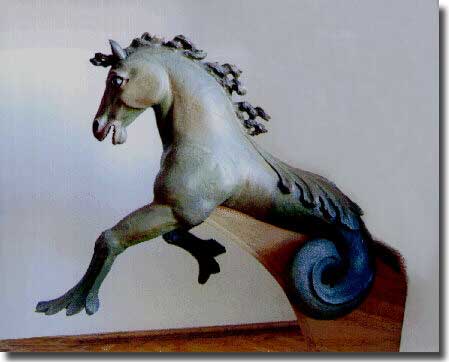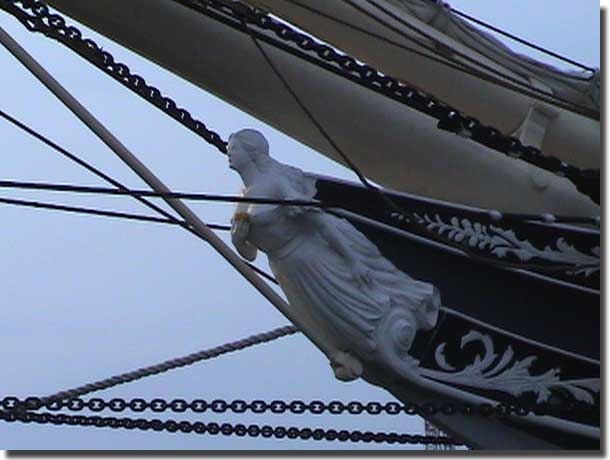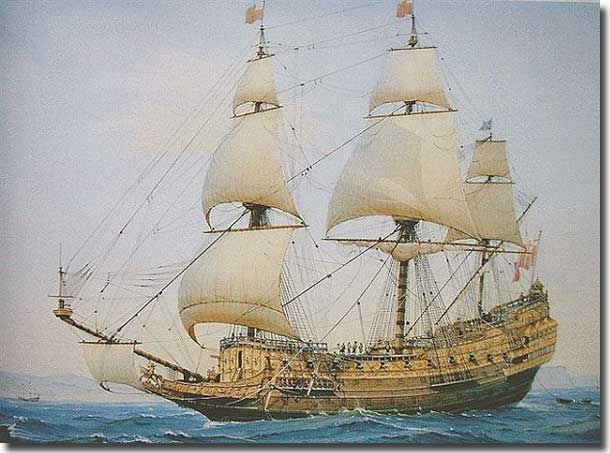|
A Brief History of the Ship's Figurehead
Introduction.
The figurehead from HMS Victory Defining the Ship's Figurehead. This type of artform dates back much much further in time.
A Seahorse Figurehead in the Piran Maritime Museum, in Slovenia, Development of the Ship's Figurehead. The Egyptians and Chinese were great sailors, and they instituted the practice of painting eyes ( Oculi ) on the bows of their vessels, so that they may find their way across the oceans. Over the period 1400-1600, many nations vied with each other for supremacy of the sea, they included:- Spain, Portugal, France, Holland and England, plus the powerful city/states of Genoa and Venice. An intimidating figurehead featured on many of the ships emanating from those nations' dockyards.
Figurehead from the Sailing ship Elissa, built in 1877, The Catholic influence on the Ship's Figurehead. Golden Hind. An expensive ship.
Soverign of the Seas The Golden Age for Figureheads. The figurehead starts to wane.
Figurehead on Falls of Clyde, at the Honolulu Maritime Museum. The fine figurehead from Count Felix von Luckner's WW1 Armed Raider Seeadler. Seeadler was fitted with a fine large wooden figurehead. By chance, the Royal Australian Navy light cruiser, HMAS Encounter, the next month was sent to inspect the wreck and salvage her guns. Two young sailors from the cruiser visited the wreck, and decided to cut off her figurehead, and managed to smuggle their trophy on board. When the cruiser returned to Sydney Australia, the two intrepid smugglers were trying to get their booty ashore, but were caught, only to have their prize confiscated. This great example of the wood carver's art then finished up at the Australian War Museum in Canberra. It was only recently this story was related to me by the son of one of the two sailors who had purloined von Luckner's Seeadler's figurehead. I contacted staff at the AWM, and asked if it were possible to locate this figurehead in their storage facilities, and could they tell me how it was acquired? and finally, if located, may I please have a photograph E-Mailed to me? A staff member quickly phoned me to say she would search their records etc. Within a few days I had an E-Mail , the figurehead had been found, a coloured photograph attached, alas no record on how it had been acquired.
Seeadler's figurehead Conclusion. I have always been interested in the exploits of Lieutenant Commander, Count Felix von Luckner as Captain of the Seeadler, and my writing about him on AHOY. Mac's Web Log, has elicited more comments from around the world than any other topic about which I have written. This man and his exploits so long ago still arouse immense interest. Thus, how lucky was I to be approached by Henry Cooper, the son of Ordinary Seaman Cooper, who with his shipwright mate had acquired this figurehead from Seeadler in 1917. I was unaware of any figurehead, let alone that it rested in our AWM, it is a fine example of an art, no longer practiced in the 21st, century. See the web site "Maritime Topics On Stamps" to see stamps containing figureheads. |






